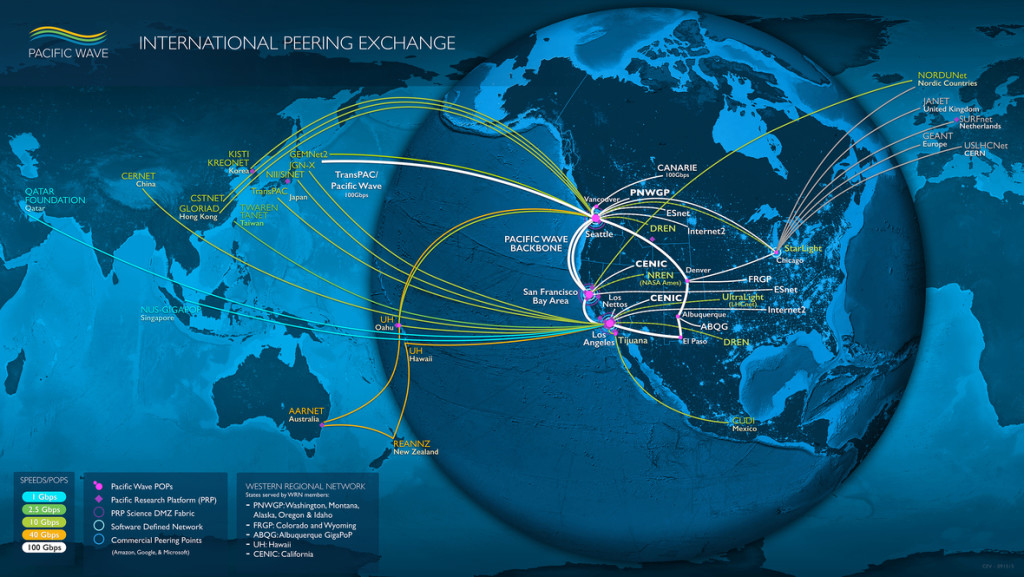The Pacific Wave project has announced that the Pacific Northwest Gigapop (PNWGP) has established the world’s first 100-Gigabit per second (Gbps) research and education (R&E) network link between Asia and the U.S., with related transit, peering, and exchange fabric.
“This milestone is great news. The world’s hardest problems can only be solved through global collaboration, and 10Gbps links will soon be insufficient to support large-scale science,” said Greg Bell, director of the Scientific Networking Division at Lawrence Berkeley National Laboratory in California, and director of the Energy Science Network (ESnet). “Faster data almost always means faster discovery. More important than bandwidth, though, is a growing spirit of international cooperation in our community: multiple stakeholders are working together towards a common goal of open, fast, and safe research networking for the world.”
“In the end, the purpose of advanced networking is to accelerate progress in research and education and to speed and broaden our impact on society,” said Dr. David Lassner, president of the University of Hawaii. “This major improvement in both the speed and sophistication in Trans-Pacific connectivity will help our global academic community do both.”
Pacific Wave will provide this 100Gbps capability to the National Science Foundation (NSF) funded International Research Network Connections (IRNC) TransPAC4 project, led by Indiana University. Pacific Wave recently received a five-year NSF IRNC award to serve as the U.S. Pacific Rim’s open and distributed interconnection, peering, and exchange fabric, including Software-Defined Exchange (SDX), Software-Defined Networking (SDN) and research DMZ capabilities.
The integrated 100Gbps trans-pacific layer 1, 2 and 3 TransPAC – Pacific Wave network fabric incorporates:
- A dedicated 100Gbps wavelength between the Pacific Wave national Research & Education (R&E) node in Seattle, U.S.A. and Tokyo, Japan
- 100Gbps peering and routing fabrics – using Brocade MLX routers – in Tokyo and Seattle
- Access and peering in Tokyo for Asian R&E networks at both the long-standing WIDE/T-REX/T-LEX Open Exchange Point, and at the newly-established Pacific Wave node at 3-8-21 Higashi-Shinagawa, Shinagawa-Ku
- The 100Gbps connection in the U.S. using Pacific Wave’s existing 100Gbps open, distributed, wide-area peering and exchange fabric, which is based on a distributed mesh of Brocade MLX routers, across the Pacific Wave backbone, and has primary points of presence in Seattle, Sunnyvale, and Los Angeles, as well as additional 100Gbps access and peering at StarLight in Chicago
- On the U.S. side, the Pacific Wave fabric provides direct 100Gbps connectivity with multiple 100Gbps interfaces to Internet2’s Advanced Layer 2 and 3 Services (AL3S and AL2S), as well as 100Gbps connectivity to ESnet, and 100Gbps and/or 10Gbps connections to nearly all the major Asia Pacific R&E networks, U.S. Department of Energy’s ESnet, U.S. National Oceanic and Atmospheric Administration N-wave, and commercial cloud providers regularly used by national and international R&E communities
- Interconnection of the U.S.-based Pacific Wave and the Japan-based WIDE/T-REX peering, exchange, interconnection and Science-DMZ facilities, creating the first intercontinental R&E open, distributed exchange and peering fabric
- Extension of the new Pacific Wave experimental SDN and SDX fabrics across the Pacific Ocean to Asia, enabling direct interconnection with Asian R&E SDN and SDX projects, including those supported by WIDE and others. GENI, OpenFlow, and related projects will also be supported
- Connectivity to Pacific Wave’s 100Gbps wide-area Inter-institutional Science DMZ network, which has primary points of presence within Los Angeles, Seattle, Sunnyvale, and which serves as the backplane for the new NSF-sponsored Pacific Research Platform
Pacific Wave is a joint project of the Pacific Northwest Gigpop (PNWGP) and CENIC (the Corporation for Education Network Initiatives in California) which is partially supported by NSF funding. Pacific Wave is a pioneering, high-performance, production-quality, open, distributed peering and exchange fabric that spans and integrates nodes across the entire west coast of the USA from Mexico to Canada and has major points-of-presence in Seattle, Sunnyvale, and Los Angeles on its purpose-built 100Gbps open peering backbone.
Now, via the new 100Gbps TransPac – Pacific Wave link, the open peering and exchange fabric extends to and includes T-REX in Tokyo. Pacific Wave interconnects nearly all of the Asia Pacific Region’s research and education networks and enables them to directly connect, on their own terms, and under their own control, to each other and to other resources in the USA and elsewhere, including the North America’s primary open exchanges such as StarLight, and North American R&E networks such as Internet2, NREN, DREN, CANARIE, AMPATH, CUDI, and to the full range of USA commodity ISPs and cloud providers.
Pacific Wave’s facilities also include (1) a second dedicated 100Gbps West Coast 100Gbps backbone, providing a production quality Science DMZ fabric and (2) the new Pacific Research Platform; and dedicated, independent, purpose-built SDX, SDN, and OpenFlow fabrics, including two separate 10Gbps links for enabling “breakable network” experimentation. All these facilities directly interconnect with Internet2’s AL2S/AL3S and other experimental fabrics. The Pacific Wave points of presence in Seattle, Los Angeles, and Sunnyvale serve as GLIF Optical Lambda Exchange Facilities (“GOLE’s”).
See the full Pacific Wave announcement at: https://madmimi.com/p/76f2d6?fe=1&pact=34020284101
Source: Corporation for Education Network Initiatives in California (CENIC)




























































